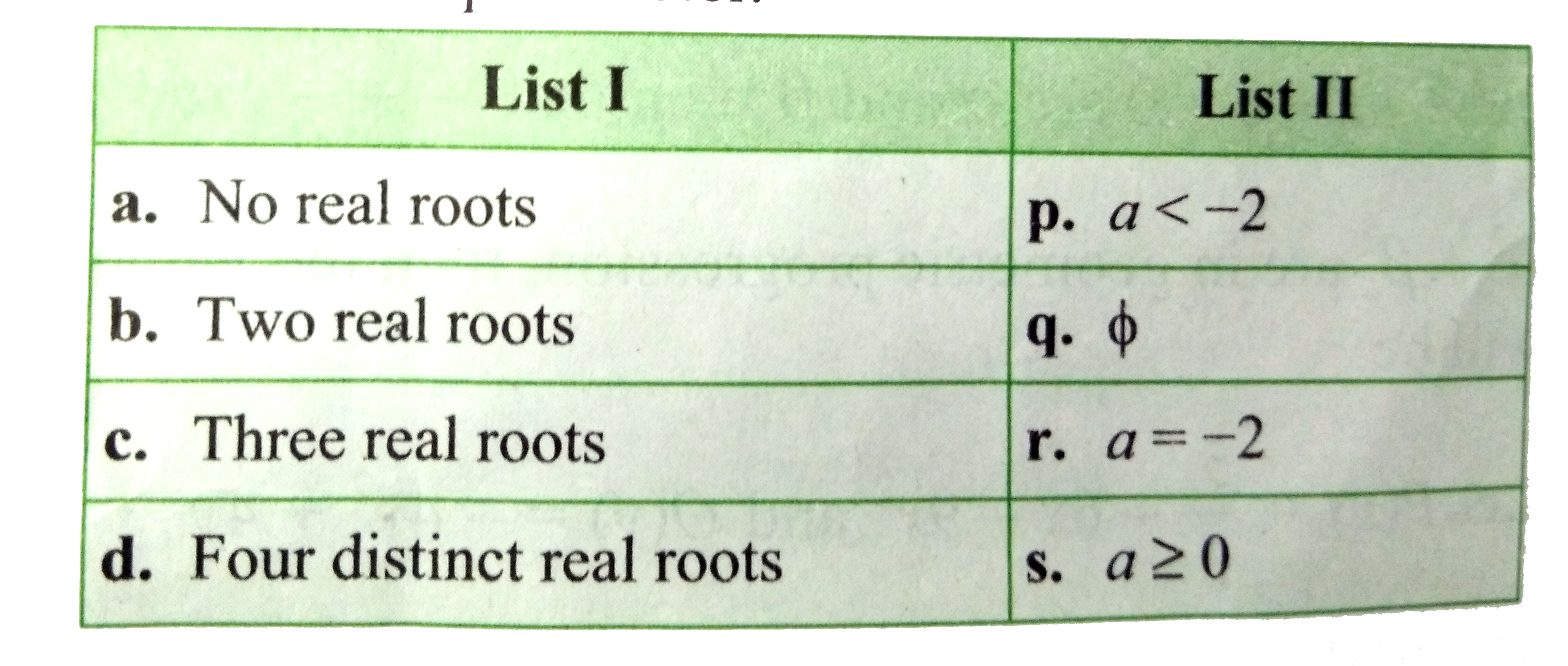If x2+ax+3x2+x+a takes all real values for possible real values of x, then a.a3−9a+12≤0 b. 4a5+39≥0 c. a≥14 d. a<14Solution in Bengali
-3
2
-1
-4
The correct Answer is:1,4
Let x2+ax+3x2+x+a=y
⇒x2(1−y)−x(y−a)+3−ay=0
∵x∈ R
(y−a)2−4(1−y)(3−ay)≥0
⇒(1−4a)y2+(2a+12)y+a2−12≥0 (1)
Now , (1) is ture for all y ∈ R , if A - 4a >0andD≤0. Hence ,
a<14and4(a+6)2−4(a2−12)(1−4a)≤0
⇒a<14and4a3−36+48≤0
⇒a<14and4a3−36+48≤0
⇒a<14and4a3<36(14)−48
⇒4a3+39<0[∵a<14]
Topper's Solved these Questions
- THEORY OF EQUATIONSBOOK - CENGAGE PUBLICATIONCHAPTER - THEORY OF EQUATIONSEXERCISE - Linked Comprechension Type
37 Videos
- THEORY OF EQUATIONSBOOK - CENGAGE PUBLICATIONCHAPTER - THEORY OF EQUATIONSEXERCISE - MATRIX MATCH TYPE
6 Videos
- THEORY OF EQUATIONSBOOK - CENGAGE PUBLICATIONCHAPTER - THEORY OF EQUATIONSEXERCISE - Single Correct Answer Type : Exercise
89 Videos
- STRAIGHT LINESBOOK - CENGAGE PUBLICATIONCHAPTER - STRAIGHT LINESEXERCISE - ARCHIVES (NUMERICAL VALUE TYPE)
1 Video
- THREE DIMENSIONAL GEOMETRYBOOK - CENGAGE PUBLICATIONCHAPTER - THREE DIMENSIONAL GEOMETRYEXERCISE - All Questions
291 Videos
Similar Questions
Consider an unknow polynomial which divided by (x−3) and (x−4) leaves remainder 2 and 1, respectively. Let R(x) be the remainder when this polynomial is divided by (x−3)(x−4).
If equations R(x)=x2+ax+1 has two distint real roots, then exhaustive values of a are.
View SolutionMatch the following for the equation x2+a|x|+1=0 where, a is a parameter.

View SolutionThe value of expression x4−8x3+18x2−8x+2 when x=2+√3
View SolutionFor a point P in the plane, let d1(P)andd2(P) be the distances of the point P from the lines x−y=0andx+y=0 respectively. The area of the region R consisting of all points P lying in the first quadrant of the plane and satisfying 2≤d1(P)+d2(P)≤4, is
View SolutionFind the angle between the line whose direction cosines are given by l+m+n=0andl2+m2−n2=0.
View SolutionIf (x2+ax+3)/(x2+x+a) takes all real values for possible real values of x, then a.4a2+39<0 b. 4a5+39≻0 c. a≥14 d. a<14
View SolutionIf x is real and (x2+2x+c)/(x2+4x+3c) can take all real values, of then show that 0≤c≤1.
View SolutionIf x,y are real and (x-1)^(2)+(y-4)^(2)=0 then the value of x^(3)+y^(3) is
View SolutionNumber of integral values of 'b' for which inequality (a^2 + 1)x^2 + 4(a+b)x +2 < 0 is true for atleast one 'x' and for all Real a, is (A)0 (B) 1 (C) 2 (D)3
View SolutionIf a and b can take values 1, 2, 3, 4 . Then the number of the equations of the form ax2+bx+1=0 having real roots is (a) 10 (b) 7 (c) 6 (d) 12
View SolutionIf 4:3=x2:12, then the value of x (x>0). 16 (b) 4 (c) 9 (d) 3
View Solution[ The number of real solutions of x^(2)-4|x|-2=0 is [ (a) 1, (b) 2 (c) 3, (d) 4]]
View SolutionIf (x−2)2(3−x)3(5−x)4(4−x)3<0, then the exhaustive set of real values of x ,is :
View SolutionIf x2+ax+3x2+x+a, takes all real values for possible real values of x, then
View SolutionThe number of real solutions of the equation ex+(a2+4a+5)x2+6=0 is
(A) 1
(B) 2
(C) 3
(D) 0
View SolutionFor all real values of x, the minimum value of 1−x+x21+x+x2is(A) 0 (B) 1 (C) 3 (D) 13
View Solution
